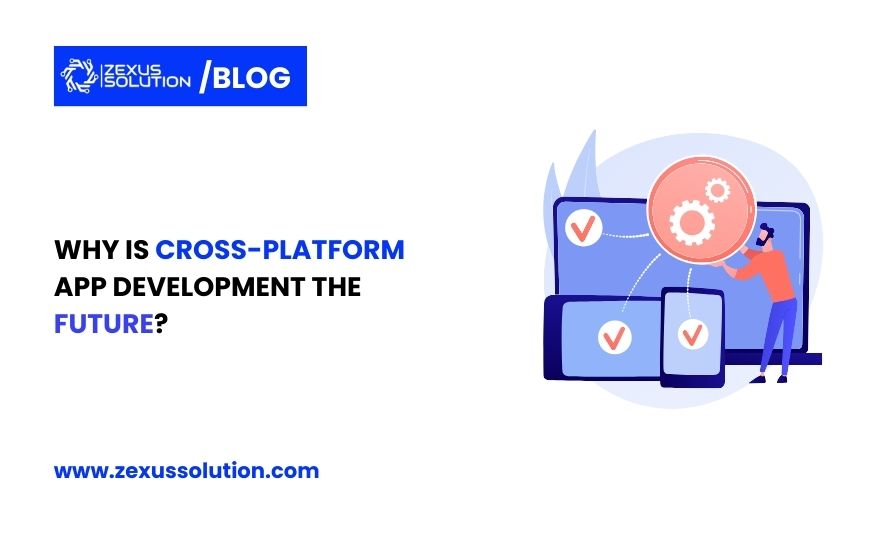Table of Contents
Technology is evolving on a regular basis and everything else is advancing along with it. In this smartphone era, the use of applications is increasing and as the era progresses, numerous new operating systems emerge. This revolution necessitates cross-platform app development.
Android and iOS are the most popular operating systems. In 2024, Android maintained its lead position worldwide with a market share of 71.65%. Meanwhile, iOS remains second with 27.62% of users worldwide (source: statista.com). Research shows that most people use smartphones to access mobile applications.
As a result, there is an increasing potential for app developers and business owners to collaborate. It’s no surprise that cross-platform app development is becoming increasingly popular. Businesses compete to get an advantage over each other by developing mobile apps that are offered in both the Apple Play store and Google Play Store.
Understanding Cross-Platform Application
As dozens of operating systems have developed, several types of mobile app developments have also emerged to align with them. Cross-platform apps are one of those mobile app developments. The source code in these apps can run on different kinds of operating systems, such as Android and iOS, without having to change it every time.
Some famous examples of cross-platform apps are Facebook, Instagram, Dropbox, Spotify and others. Whether you are an Android or an iOS user, these apps are compatible with both.
Key Benefits of Cross-Platform App Development

Android App Development has always been in the lead, but with the changing market, there is an increase in the development of cross-platform apps. Around 80% of developers are using or have plans to use cross-platform apps. This shows the increasing potential of cross-platform app development.
Some of the key benefits of Cross-Platform Development are as follows:
1. Wider Accessibility:
Cross-platform apps can be used in multiple operating systems, making them accessible to a broad audience. From iOS users to Windows, it allows a wide range of users to utilize the platform.
2. Cost-Effectiveness for the Users
Typically, cross-platform applications are less expensive on the user’s side, especially regarding app purchases and subscriptions. Most people only need to buy the app once, as it is accessible in multiple processing systems. For instance, an iOS app will only be accessed on iOS devices, and there will be a need to buy it again for other platforms. This is different for cross-platform apps.
3. Seamless User Experience
Cross-platform development brings numerous advantages with one of the most vital being the ability to present a consistent user experience across all platforms. Whether users are on an Android phone, an iPhone, or even accessing the web version of the app, the interface, design elements, and fundamental features remain largely intact. This homogeneity enables users to resume from wherever they last stopped, irrespective of the device they are using.
4. Better Time- Management for Users and Developers
Time is saved for both end users and developers alike in cross-platform app development. To expand, in software development, instead of creating an application that targets the iOS and Android operating systems separately, application developers can opt to use a single code base that will serve all the platforms. This is even more favorable in iOS app development in that instead of the developers making a different version of the app for iOS, the app can be designed in such a way that it can work on iOS, Android, and other operating systems. This makes it possible to release new features, improvements, and corrected errors much faster.
5. Eco-friendliness
Since it minimizes the use of considerable resources and energy needed to develop and manage distinct applications for each platform, cross-platform development is resource-efficient. By consolidating development into a single codebase, the overall carbon footprint of the development process is smaller. This includes, for instance, reducing the number of servers able to be used or reducing the energy spent on testing and deploying procedures.
6. Quicker Release of Changes and Correction
In cross-platform frameworks, developers are able to deploy updates and fixes simultaneously, which is an added advantage. In this regard, users will not have to experience delays due to the wait for updates released for a specific device. If there is a bug to be fixed in the system or a new element is added, it makes it possible with cross-platform applications to make a change on all systems simultaneously so that all users have the same effective experience. For example, when a social media app fixes a messaging bug on iOS devices, the same update will be made available to Android and web users at the same time, preserving consistency across different platforms.
7. The Betterment Of Interaction And Distribution
Due to cross-platform applications, users are able to collaborate and share content more effectively, and on any device. This is even more critical for work environments since team members might be using different platforms. For instance, mobile applications such as Google Drive or Slack provide users on Android, iOS, and web platforms the ability to work on documents, exchange files, and chat all at the same time. Users of different devices can work together most times without changing to a particular platform increasing teamwork levels and productivity. This feature is essential in organizations and even normal users who wish to share information across different mediums, work on projects, or talk to their family and friends.
Why do Business Owners Prefer Cross-Platform App Development?

Cross-platform app development offers numerous benefits in terms of expenses, audience size, and turnaround time which explains why business owners are not shying away from this developing trend. One such factor is that cross-platform app.
evelopment provides businesses with the possibility of appealing to a larger population without the need to create diverse applications for every different platform, be it IOS, android, or even web. This cuts down on the amount of development time and costs related with creating separate apps for every platform. Using a common code base allows enterprises to make sure that their apps are published on several platforms and across devices to maintain the same user interface.
In addition, cross-platform mobile application development reduces the burden of making changes and supporting the application over time. Rather than business owners having to support two separate versions of an app at the same time for iOS and Android, the emphasis is on one code base and thus less pain in enhancements. This also means that fixing issues and adding new features in a staggered rollout is easier, and everyone benefits from improvements at the same time. Moreover, it minimizes the need for extensive web app maintenance tasks, as the updates are applied across all platforms simultaneously, saving both time and resources.
Companies will be able to reap the benefits of cost and efficiency of cross-platform development enabling them to focus on the growth areas of the business, for instance, marketing or customer support. The lower time and money investment needed to develop and support a cross-platform application ensures that even in extremely dynamic markets, businesses do not lag behind.
The Future of Cross-Platform App Development.

As we look ahead, it can be confidently asserted that the prospects of cross-platform app development are bright owing to the innovations in technology. It is apparent that development is now more optimized and powerful thanks to frameworks such as Flutter and React Native.
There is an expectation that Flutter will grow beyond the current versions, with better performance and superior native component integration which will appeal to developers in a hurry to deliver an appealing interface. As developers ensure rich community and versatile app solutions for React Native-based projects with demanding continuous updates, the framework’s acceptance among the developers is predicted to further increase.
Over time as the cross-platform toolings improve, the distinction between native applications and cross-platform applications will become narrow, and there will be better elevated performance, scalability, and maintenance. This is likely to enhance the interest of businesses in cross-platform app development, as it will enable quicker and easier app deployment on various platforms with minimal resources.



Add a Comment